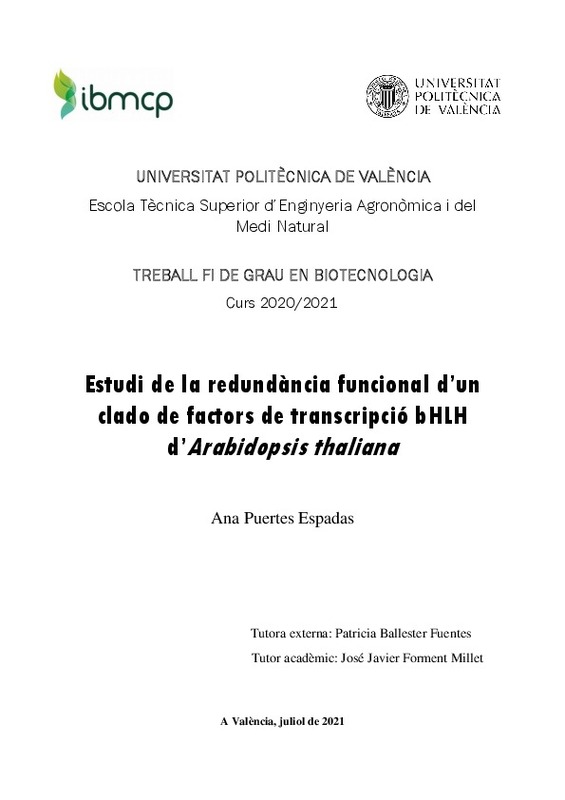|
Resumen:
|
[CA] les proteïnes bHLH són una superfamília de factors de transcripció en plantes que en
Arabidopsis thaliana controlen una diversitat de processos que van des de la proliferació cel·lular
fins a l'establiment del ...[+]
[CA] les proteïnes bHLH són una superfamília de factors de transcripció en plantes que en
Arabidopsis thaliana controlen una diversitat de processos que van des de la proliferació cel·lular
fins a l'establiment del llinatge cel·lular. Entre les proteïnes d'esta família es troben les HECATE,
codificades per 3 gens diferents (HECATE1, HECATE2 i HECATE3), que estan involucrades en
el desenvolupament del septum, del tracte de transmissió i de l'estigma. Combinacions de distint
ordre entre els mutants corresponents en HECATE causen un grau variable d'infertilitat en les
plantes. La proteïna INDEHISCENT (IND) també pertany a este grup i participa en la regulació
de la dehiscència del fruit, necessària per a la dispersió de les llavors contingudes en el seu
interior.
En altres espècies es va estudiar la funció dels gens homòlegs a HECATE3 i es va observar que
quan es mutaven, es produïen defectes en la formació de teixits transmissors (tracte i estigma) i
en la dehiscència del fruit, però també provocava la indehiscència de les anteres, per la qual cosa
es va concloure que este factor participava de manera activa en la seua obertura, funció d’alguna
manera relacionada amb la que tenia IND en fruits d’Arabidopsis thaliana però no observada en
les anteres. Així doncs, va sorgir la hipòtesi d’una possible redundància més ampla dels gens
HECATE junt amb el gen INDEHISCENT, pròxims filogenèticament, en la dehiscència de les
anteres d’Arabidopsis thaliana, i este estudi és precisament el que es va a dur a terme en aquest
treball. Per a això, es procedirà a la identificació d’un quàdruple mutant hec1hec2hec3ind,
genotipant una població segregant, amb l’objectiu d’estimar la redundància funcional d’estos 4
factors de transcripció mitjançant la caracterització fenotípica dels mateixos. A més a més, per a
continuar i reforçar l’anàlisi d’aquest treball, es va a crear la construcció
HEC3p:HEC3(CDS):GR, mitjançant la tecnologia GoldenBraid, amb l’objectiu de generar
plantes transgèniques i observar les conseqüències de la seua expressió en elles.
[-]
[EN] The bHLH proteins are a superfamily of transcription factors in plants that in Arabidopsis
thaliana control a variety of processes. Among the proteins of this family are HECATE, encoded
by 3 different genes (HECATE1, ...[+]
[EN] The bHLH proteins are a superfamily of transcription factors in plants that in Arabidopsis
thaliana control a variety of processes. Among the proteins of this family are HECATE, encoded
by 3 different genes (HECATE1, HECATE2 and HECATE3), which are involved in the
development of the septum, the transmission tract and the stigma. Different order
combinations between the corresponding HECATE mutants cause a variable degree of
infertility in plants. The INDEHISCENT (IND) protein also belongs to this group and participates
in the regulation of fruit dehiscence, necessary for the dispersion of the seeds contained
inside.
In other species the function of genes homologous to HECATE3 was studied and it was observed that
when they were mutated, defects were produced in the formation of transmitter tissues (tract and stigma)
and in the dehiscence of the fruit, but also in the indehiscence of the anthers, so it was concluded that
this factor participated actively in their opening, a function in some way related to which had
IND in fruits of Arabidopsis thaliana but not observed in the anthers. Thus, the hypothesis
arose of a possible broader redundancy of the HECATE genes together with INDEHISCENT,
which are phylogenetically close, in the dehiscence of the anthers of Arabidopsis thaliana, and
this study is precisely the one that will be carried out in the TFG. To do this, we will proceed to
the identification of a quadruple mutant hec1 hec2 hec3 ind, genotyping a segregating
population in order to estimate the functional redundancy of these 4 transcription factors
through their phenotypic characterization. In addition, to continue and reinforce the analysis
of this work, the construction pHEC3: HEC3: GR will be created, using Golden Braid technology,
with the aim of generating transgenic plants and observing the consequences of their
expression in them.
[-]
|







